Suggestions for Matching the Paint Dilution and Airbrush Nozzle to the Spray Job
by John Miller


Hobby Boss' 1/72 P-61A Black Widow is available online from Squadron.com
While attending the annual meeting of the International Plastic Modelers Society (IPMS) held in Phoenix and hosted by IPMS/Arizona-Craig Hewitt Chapter, I demonstrated Fine-Line airbrushing techniques and chatted with many, many modelers and airbrush aficionados. During these conversations many guys described the most common problems they have diluting and spraying acrylic paints.
While traveling home I reflected on all those conversations and it occurred to me that many (most?) of the problems I heard from guys at the show are identical to the airbrushing issues I receive in emails from disgruntled modelers all over the world on a regular basis.
Based on those conversations and emails I’ve compiled the top Four Most Common Airbrush Problems experienced by modelers diluting and spraying acrylic paints and clear coats (Gloss and Flat).
They are:
-
Intermittent Clogging
-
Unreliable Performance
-
Difficulty Spraying Fine Lines
-
Rough, Pebbly Finishes
The most common problem, Clogging, followed closely by Unreliable Performance and Difficulty Spraying Fine Lines are all issues related to spraying paint that is too thick combined with not cleaning the airbrush sufficiently. (For suggestions on keeping your airbrush clean see Suggestions for Getting the Gunk Out.)
In addition to preparing more dilute mixtures of paint, the inclusion of a wetting agent or paint retarder such as Liquitex Flow Aid will decrease clogging and intermittent spraying as well, especially for those spraying in warm, arid climates (more below).
The third and fourth most common problems, Difficulty Spraying Fine Lines and Rough Finishes, are most often related to using too thick a paint mixture and not using an appropriately sized airbrush tip for the job.
"Tip" refers to the nozzle aperture (in millimeters) where small tips are around 0.20mm and larger tips start at around 0.40mm.
Matching the airbrush tip size to the specific spray job is easily addressed as many airbrush manufacturers produce different sized tips for their brushes including Harder-Steenbeck, Iwata, Badger, Grex, and Aztec.
Full Disclosure
This article references airbrush tips made by Harder-Steenbeck and fitted to H&S Infinity or Evolution dual-action airbrushes. After trying many brushes I settled on the Infinity and have driven one for 10 years due to the selection of different sized tips available and the degree of control it provides for Fine-Line airbrushing. For more information on Fine- and Super-Fine-Line airbrushing and configuring the Infinity, go to Model Paint Solutions.
Matching Dilution and Nozzle to the Spray Job |
Matching the tip size and paint dilution to the particular airbrush job are the surest ways of easily addressing the Top Four Airbrushing Problems.
I group the types of airbrushing jobs required to assemble and finish most scale plastic models into four basic categories:
-
Fine-Line
-
General
-
Spraying over Pre-Shading (Modulation)
-
Clear Coats (Gloss and Flat)
Please bear in mind that what follows are only suggestions based on my skill set and experience. There are as many good techniques for spraying fine lines and clear coats as there are modelers loading up their airbrush paint cups. With that in I mind, please take you find useful, combine it with your own experience, and develop a technique that works best for you.
Thoughts on Matching the Airbrush Tip to the Job
Many modelers just starting out naturally try to make one tip size work for all jobs. I did this myself for many years and was quite happy in the process thank you very much.
That said, with experience comes a finer eye for finishes and for me, the realization that matching the tip size to the spray job produces a finer finish and, most importantly, makes the job easier and more enjoyable, which is really what its all about.
Most airbrushes intended for modeling come fitted with one tip ranging in size from 0.20 to 0.50mm: that's a wide range. I find that a tip size of ~0.30mm is great for General work but not suited for either Fine-Line work or spraying a Clear Coat (more below).
To be clear, there are many experienced modelers that can shoot perfect fine lines and clear coats with a 0.30mm tip. That said the smaller the tip, the more capable the tip is of spraying a thin line. In my hands fine and super fine-lines (less than 1mm) are both easier and more reproducible when shot with tips of 0.20mm and smaller. Likewise using too small a tip for applying a clear coat can lead to a rough final finish.
I could not have sprayed the camo on this 1/144 I-16 had I not used a 0.15mm tip. Having "the right tools for the right job" makes the work easier and way more enjoyable.

Thoughts on Preparing Paint Dilutions for Specific Spray Jobs
Many modelers that complain of having to deal with one or more of the Top Four Airbrushing Problems use one dilution of paint (often 50%) for every type of spray job. Many of their models are beautifully built with smooth, even finishes. However, the builders often describe suffering through many sanding, buffing, and surface preparation tricks they used to get a nice finish.
These extra tricks are often required to compensate for the rough, pebbly finish imparted to the model by a too-thick mixture of paint or clear coat compounded by not using an appropriately sized tip.
A thick dilution of paint will clog the brush more often, not easily spray fine lines, produce a rough, pebbly finish, and serve to fill-in or soften inscribed surface details. A good working rule is:
"The thinner the layer of paint, the better."
What follows are suggestions for diluting acrylic paints for each of the four basic types of airbrushing jobs, Fine-Line, General, Modulation, and Clear Coats. By acrylic paints I'm referring to brands such as Tamiya, Mission Models*, Vallejo, LifeColor, AKAN, and Model Master. For suggestions and examples of how to prepare percent paint mixtures and tools to make the job quick and easy go here.
*Note: Mission Models is my go-to brand for primers and paints however it requires a higher percent paint mixture than do most acrylics. Please refer to specific articles for suggestions on diluting Mission paints.
There are many (many) texts describing strategies for diluting acrylic model paints for airbrushing. I'll restrict my suggestions to two additional guidelines: 1) Use the manufacturers thinner for whatever brand of paint being sprayed, and 2) Add a paint retarder or flow enhancer to lessen tip dry and pebbly, over-spray while increasing leveling.
There are many such reagents available but the brand I find works best with all the acrylics I’ve tested is Liquitex Flow-Aid added to ~5-8% by volume.
Fine- and Super-Fine-Line:
Percent Paint: 10-25%
Tip Sizes: 0.15 to 0.20mm
To shoot lines of ~1mm in width or Fine Lines, I dilute most acrylics to 20-25% paint with the balance made up with thinner (to 100% volume). When this dilution is sprayed at ~10psi with a working distance (tip to model) of 1-2cm (1/2-3/4in), it will provide thin, clean lines with minimal over-spray.
To spray Super Fine Lines of 1mm or less (0.30 to 0.50mm) I dilute acrylics further to 10-20% (depending on the acrylic) and spray at 6-8psi. The ability to reliably reduce air pressure to less than 10psi makes shooting super fine lines easier and more reproducible.
To configure my compressor for super fine-line work I set the compressor gauge to deliver 10psi. This is reduced further using an In-Line Air Valve to a "guesstimated" 6-8psi (based on the feel of the air pressure against my hand).
Using AKAN and Gunze lacquers diluted for Super Fine-Line spraying, the scheme on this Zvezda 1/144 I-16 was shot at 6-8psi using a 0.15mm tip and a working distance of ~1cm (~1/3 in).
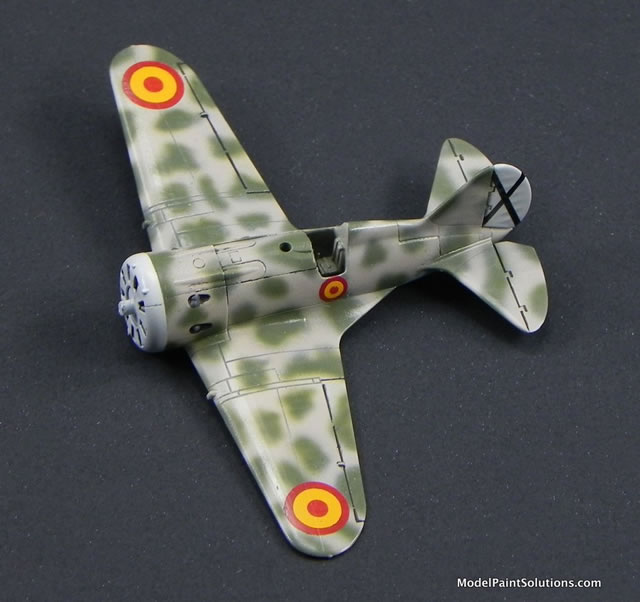
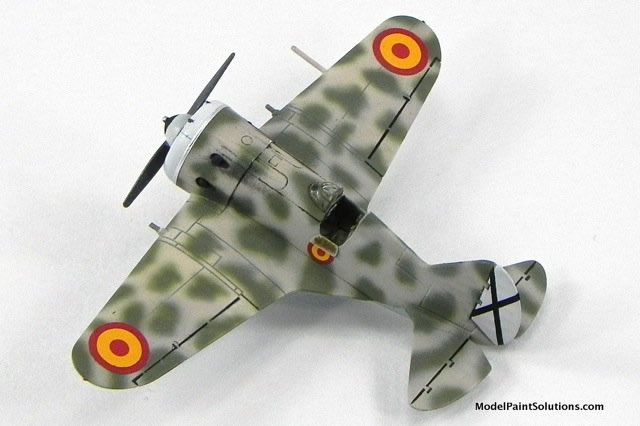
As an example of mottling in a larger scale, the scheme on this Hobby Bossy 1/72 Macchi Saetta was shot with Mission Models paints diluted for Super-Fine-Line and applied at ~8psi using a 0.15mm tip.
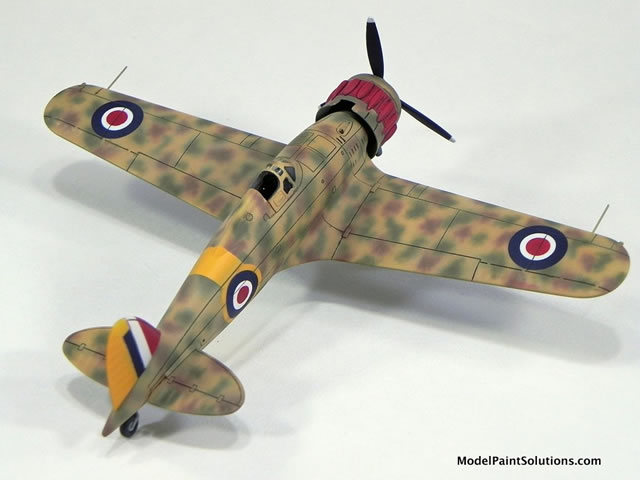
Similar to the Saetta above, the mottling on this 1/72 AZ Models Me-109G V-Tail was shot with Mission Models Paint diluted for Fine-Line work and applied at ~6-8psi with an Infinity fitted with a 0.15mm tip.

General Spray Jobs:
Percent Paint: 30-40%
Tip Sizes: 0.20 to 0.35mm
For the majority of airbrushing jobs during assembly I dilute most acrylics to roughly 30-40% paint with the balance made up with thinner (to 100% volume). This dilution range gives good coverage for General jobs when sprayed at 12-15psi with a working distance of 8-10cm (3-4 in.).
Tips in the range of 0.20 to 0.35mm are well suited for General spray jobs such as parts stuck to a painting board or assemblies.
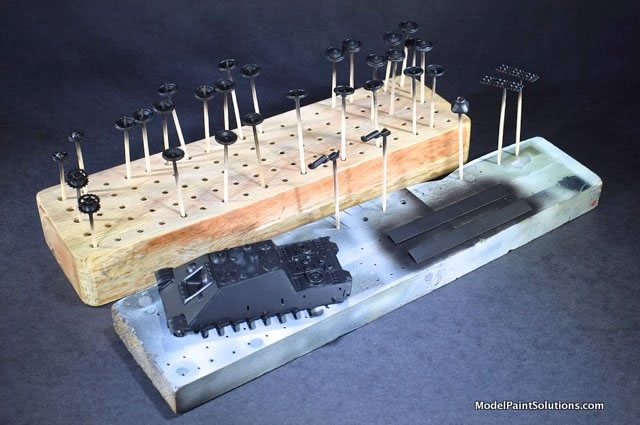

A tip of 0.20 to 0.35 is also well suited for applying schemes to larger models where a slightly wider line is more scale appropriate as with this Hobby Boss 1/48 Focke Wulf Fw190 V18, 1/48 Classic Airframes DeHavilland Hornet, and 1/48 Special Hobby Wirraway.
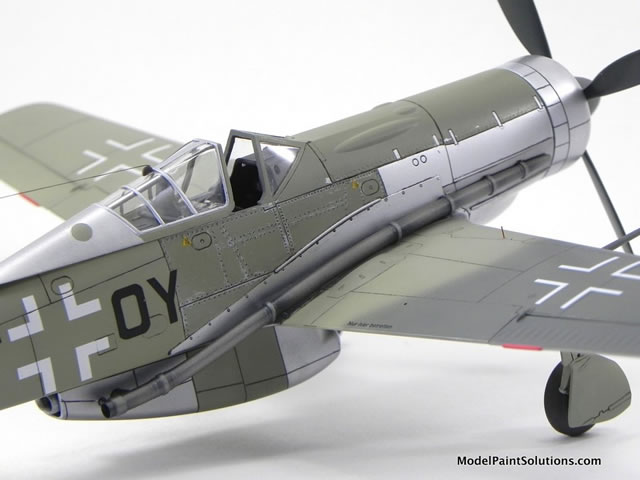
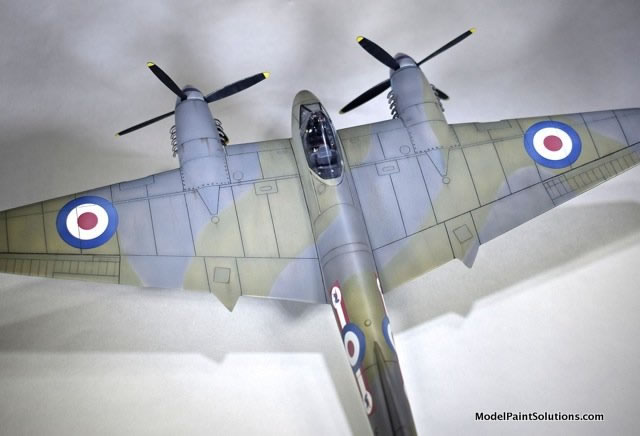
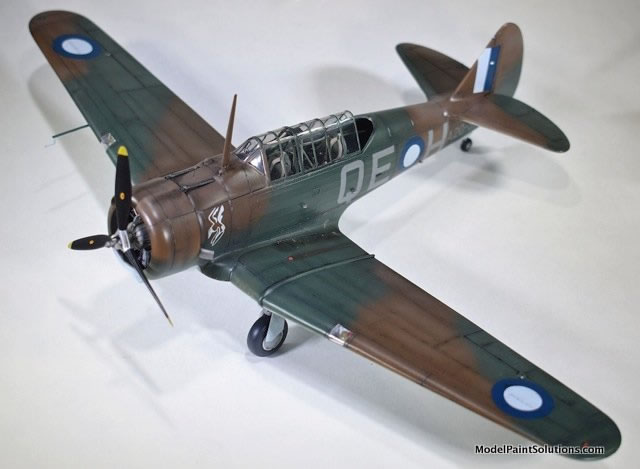
Spraying over Pre-Shading (Modulation):
Percent Paint: 10-25%
Tip Sizes: 0.20 to 0.35mm
If I’m going to be spraying over pre-shading a process called “modulation” as so well described by Adam Wilder, the ideal sized tip will largely depend on the size of the model.
For example, consider spraying the 1/72 Hobby Boss Saetta light yellow-tan (Italian Giallo) after being primed with Mission White Primer (using 0.20mm tip) and the panel lines pre-shaded with Mission Slate Gray (using a 0.15mm tip).
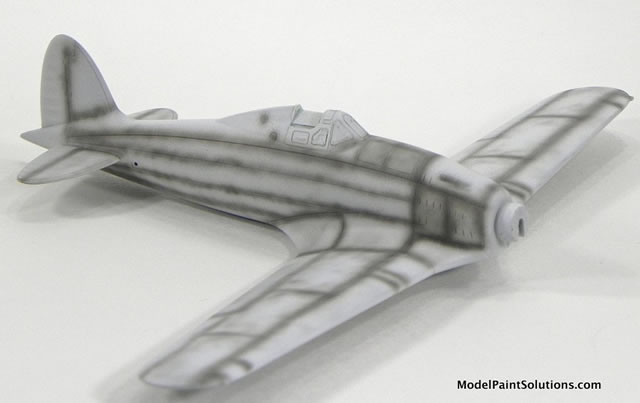
When over-spraying pre-shading like this, I’ll typically use a dilution of 10-25% paint (balance in thinner). A low paint dilution will require more passes to attain sufficient coverage. However, requiring additional passes provides better control over the density of the coverage and lessens the chance of applying too heavy a coat and loosing the pre-shading.
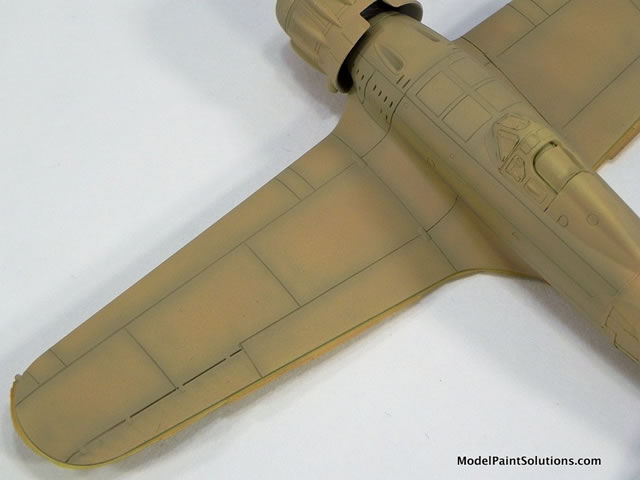
For a model the size of a 1/72 Saetta (or a comparably sized area on a larger model: see below), I prefer using a 0.20mm tip although tips of up to ~0.35 would work as well.
Bear in mind, even larger tips can be made to work especially by some one with experience. That said using a larger tip increases the likelihood of spraying too heavy a coat. Conversely, using a small tip increases the chances of getting a rough, pebbly finish.
You may note that the RAF Ocean Gray and Dark Green areas on this Classic Airframes 1/48 Hornet are roughly the same size as the wings or fuselage of, oh say maybe a 1/72 Saetta?
As with the 1/72 Saetta, each color (LifeColor acrylics) was diluted to ~25% and applied with a 0.20mm tip. That combination provided better control over the degree of coverage allowing the pre-shading (done with a 0.15mm tip) to show through the final coat. To accomadate the large area of the model (especially the wings) the RAF Blue (LifeColor) on the belly and all Clear Coats and Primers were applied with a 0.40mm tip.
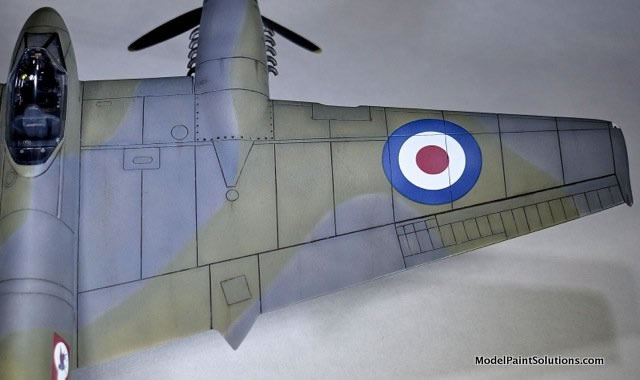
Final Considerations on Modulation:
The wide range of paint dilutions suggested (10-25%) is due to the many variables that have to be taken into account when deciding on the optimal dilution. They include:
- The color of the primer: white, black, gray or?
In general, darker primers require higher concentrations of the color being spayed over them, especially if the color is light such as yellow or white.
- The color of the pre-shading: black, gray, brown or?
Similar to compensating for the color of the primer coat, black pre-shading often takes extra passes to achieve sufficient coverage and blending with surrounding areas.
Percent Clear Coat: Variable (see below)
Tip Sizes: 0.40 to 0.60mm
On the opposite end of the spraying spectrum from Fine-Lines would be laying down Clear Coats. I also include Primers in this category as they especially should be applied with larger sized tips but primers are beyond the scope of this article.
Gloss Coats:
There are many different acrylic gloss coats available and each has its own set of strengths, weaknesses, and requirements with regards to best dilution and application. Many clear coats like Alclad Aqua Gloss and Future Floor Wax (or Pledge with Future Shine as its now called) are often sprayed neat (straight from the bottle) or diluted very little.
In contrast I get the best results with acrylic gloss coats like those by Mission Models, Tamiya, and Vallejo when they’re diluted with their respective thinners to 30-50% gloss. Your mileage may differ. Whatever dilution used I apply the same general rule of “the thinner the coat, the better” to all gloss coats.
In addition to providing a smoother finish, a thin coat of gloss will facilitate the wicking of washes within inscribed lines and along the crisp angles of surface details. A heavy coat of gloss will tend to fill these areas in and soften the detail.
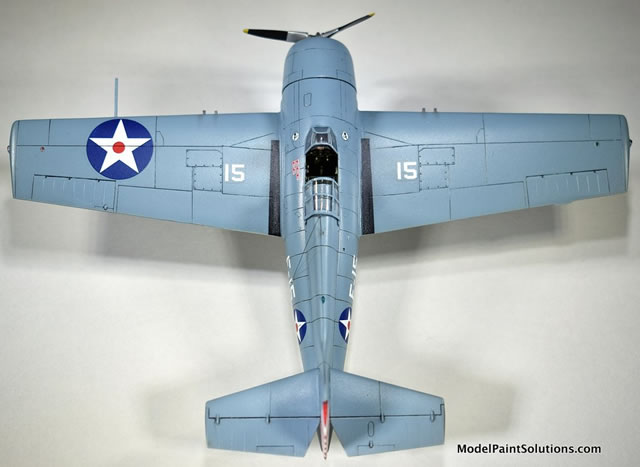
Flat Coats:
With the myriad of clear acrylic flat coats available there is no one dilution that would work for them all. That said the general rule of “the thinner the coat, the better” should especially be applied to flat or semi-flat coats.
Modelers of military vehicles tend to apply too heavy a coat of flat. This is especially true for aircraft models. To lessen the chances of applying too thick a coat, I err on the side of less is more and dilute my Clear Flats to 10-25% depending on the manufacturer and the degree of flat I’m looking for.
In general, I apply clear coats to large 1/72 and most 1/48-1/32 scale models using a 0.40mm tip or larger. Application of clear coats with larger tips will produce finishes that are smoother and more even.
As previously mentioned, exceptions have to be made in lieu of size, as with the application of clear coats to 1/144th scale models using a 0.20mm tip such as on this 1/144th AFV Sea King.
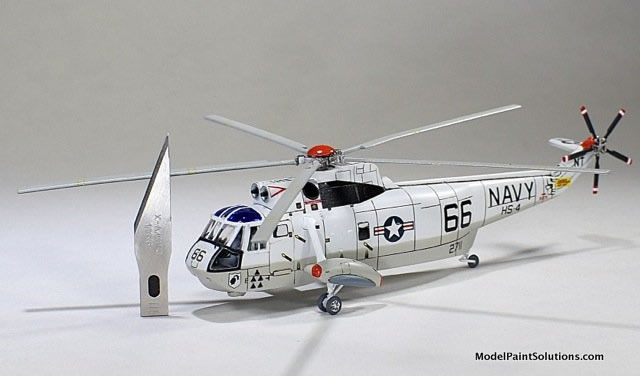
A more typical example is the Modelsvit 1/72 M17 Stratosphera. To accommodate this rather large model and to achieve as smooth a finish as possible all the primers, paints, and clear coats were all applied using a 0.40mm tip.
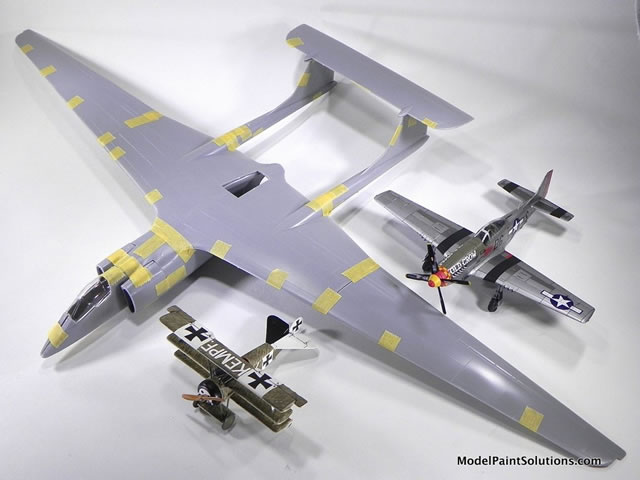
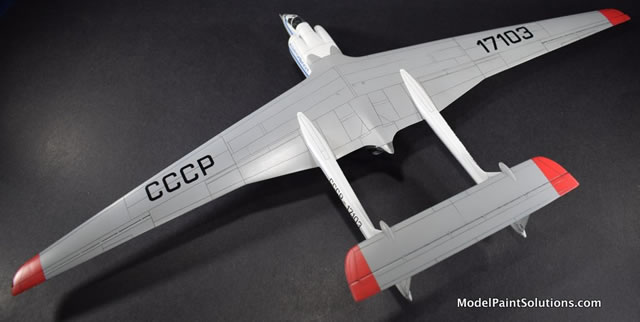
The following table attempts to summarize the previous suggestions on paint dilution, tip size, air pressure, and working distance.
As with all suggestions, please use them as a starting point to find the combination of that works best with for you and don't forget to have some fun while doing it.
Job |
Tip Size |
Percent Paint |
PSI |
Work Dist. |
|
|
|
|
|
Fine-Line |
0.15-.20 |
10-25 |
6-8 |
1-2 cm |
|
|
|
|
|
Modulation |
0.20-.40 |
20-30 |
~12 |
4-8 |
|
|
|
|
|
General |
0.20-.40 |
30-40 |
12-15 |
4-6 |
|
|
|
|
|
Clear Coats |
0.40-.60 |
Variable |
15-18 |
8-10 |
As a way of illustrating matching paint dilution and tip size to the job, this information (and more) is provided on multiple models ranging from 1/144 to 1/48 below.
1/144th AFV Club Sea King
Tip Size--Paint Dilution |
Application |
|
|
0.20mm |
Primer |
0.20—General |
Assembly |
0.20—General |
Spraying White on Fuselage |
0.15—General |
Spraying Gray on Fuselage |
0.20-- Thin as Possible |
Clear Coats |
1/72 Academy Messerschmitt Me-262 A-1a
Tip Size--Paint Dilution |
Application |
|
|
0.20mm—General |
Assembly |
0.2 |
Primer |
0.15--Fine-Line |
Pre-shading |
0.20—Modulation |
Spraying over Pre-shading |
0.15--Fine-Line |
Post-shading |
0.20—Thin as Possible |
Clear Coats |
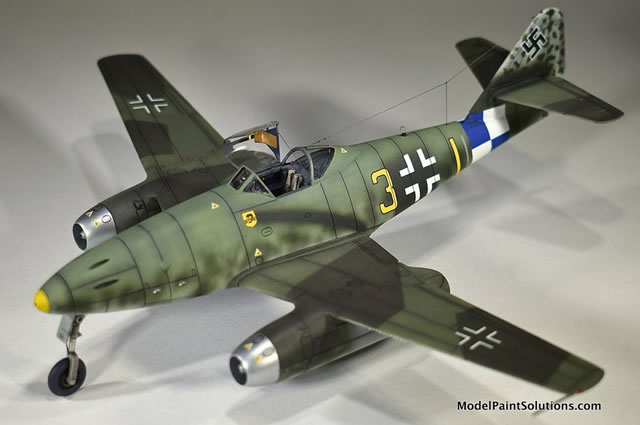
The utility of using a lower dilution (10-25%) for paint modulation (spraying over pre-shading) is illustrated by the faint pattern of vertical and horizontal lines (representing puttied fuselage panels) that can be seen underlying the camouflage of this Me-262. The "putty lines" are best seen in the lighter shaded areas just below and behind the cockpit.
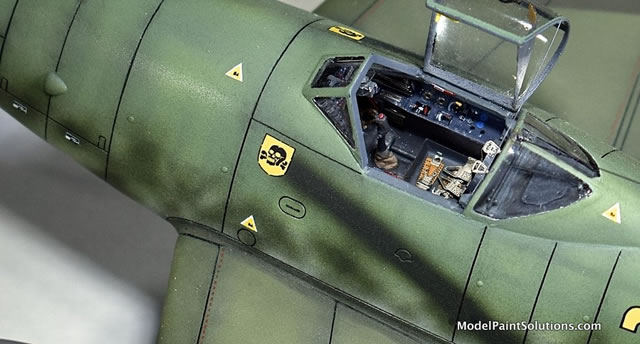
1/48 Special Hobby CAC Wirraway
Tip Size--Paint Dilution |
Application |
|
|
0.20-General |
Assembly |
0.40mm |
Primer |
0.15--Fine-Line |
Pre-shading |
0.20—Modulation |
Applying Tan and Green |
0.15--Fine-Line |
Post-shading |
0.40—Modulation |
Gray on Belly |
0.40-- Thin as Possible |
Clear Coats |
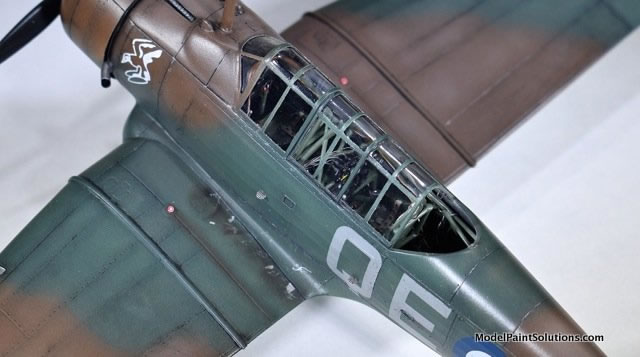
Thanks for reading along! I hope that served to give you a starting point for matching the airbrush tip, paint dilution, and pressure to the painting job at hand.
Cheers!
For more information on matching paint dilution and airbrush tip to the spray job, visit ModelPaintSolutions.com
Text and images copyright © 2018 by John Miller/Model Paint Solutions.
Review Text and Images Copyright © 2018 by John Miller
Page Created 27 September, 2018
Last updated
27 September, 2018
Back to HyperScale Main Page
Back to Reviews Page

|
Home
| What's New |
Features |
Gallery |
Reviews |
Reference |
Forum |
Search